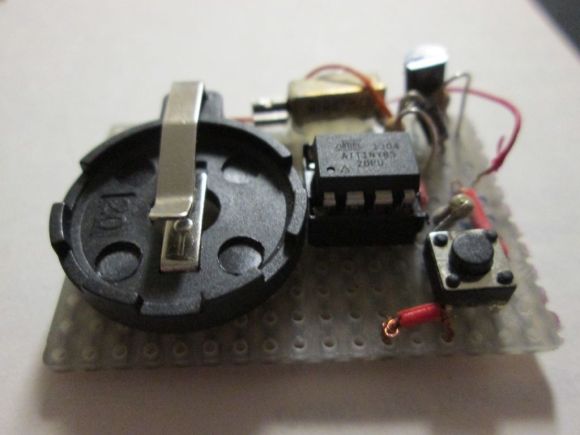
It may not look like much, but the above pictured device is [qquuiinn’s] handy little watch that indicates time through pulsed vibrations. Perhaps we should refrain from labeling it as a “watch,” however, considering it’s [qquuiinn’s] intention to remove the need to actually look at the thing. Vibrations occur in grandfather clock format, with one long vibration for each hour, accompanied by one, two, or three short pulses for the quarter-hour increments.
The design is straightforward, using an ATTiny85 for the brains along with a few analog components. The vibration motor sticks to the protoboard with some glue, joining the microcontroller, a coin cell battery, and a pushbutton on a small protoboard. The button allows for manual time requests; one press responds with the current time (approximated, probably) in vibrations. The build is a work in progress, and [qquuiinn] acknowledges the lack of an RTC (real-time clock) causes some drift in the timepiece’s accuracy. We suspect, however, that you’d address that problem—twice daily—when you replace the battery: it only lasts ten hours.
















Eeek. he really needs to fix power management on that. Long puse for top of hour short for bottom of the hour. manual gives you more details.
A CR2032 provides only 3.0V nominal, for 0.2mA. At the current drawn by even a tiny vibration motor, it’s not at all surprising that a slightly discharged cell would drop below the minimum voltage spec of the ATTiny85 when the motor went off.
Also, I note that an external pulldown resistor is being used for the pushbutton. I wonder why the internal pull-up isn’t being used instead?
Maybe instead of a vibration, he could send the signal into an autotransformer from a camera flash, and shock him. That might consume less current…. B^)
+1 It’s amazing what a few volts thru a booster can have…
Should look into isolating the motor (or shocker :) power from the uC by
means of a few hundred ohms series resistor and a large capacitor. As
pointed out, the coin cell has high internal resistance and isn’t good
for high current drains.
Sort of like those solar bots, the large capacitor holds the energy for
the motor and *slowly* charges up between twitches. The resistor keeps
the charging current low to reduce dips.
Interesting concept – don’t know about others, but I’d likely smash the thing with a hammer within the first hour of wearing it as it would be too much of a distraction. ;)
My phone vibrates all day from texts and updates from Hackaday :D. Any more from other sources (that don’t provide any helpful distractions from work) could possibly drive me up the wall!
But more on point… I saw this post the other day before it was posted here and had concerns about power managment myself. It seems difficult to belive the coin cell would last more than a couple of days before the voltage dropped below what is needed for the mcu oor (even) the motor. I think one of the *impossibly* small lipos would be a better choice.
http://hackaday.com/2013/10/11/light-up-earrings/
I tend to want to smash my phone if I get too many messages / calls as well, which is probably why I leave it on silent most of the time anyways. ;)
Your obviously not a woman. ;)
And yeah, busy-looping waiting for a button press isn’t gonna help matters either. ATTinys can give you impressive power usage, but you’ve got to set up your interrupts properly.
I recently came up with the idea for a tactile watch to use for when looking at a watch would be considered rude (like when in a lecture). This is very similar to what I had in mind.
RTC is the “cop out” for lazy person. If you know the watch is always 10
seconds fast after 5 hours, the software *can* trim back a second every
5x60x60/10 = 1800 seconds. You can even compensate for temperature.
“Low power crystal/oscillator for AVR watch…”
http://www.avrfreaks.net/index.php?name=PNphpBB2&file=printview&t=125629&start=0
Scroll down to 3rd post for a list of links on keeping time accurate.
Also scroll down for “AVR Watch” and pictures etc.
Here’s a similar commmercial version that vibrates every 5 mins, altough I would much prefer the Grandfather clock routine that qquuiinn’s follows. Nice project!
http://www.fubiz.net/en/2014/01/07/vibrant-watch/
Here’s a similar commercial version that vibrates every 5 mins, although I would much prefer the Grandfather clock routine that qquuiinn’s follows. Nice project!
http://www.fubiz.net/en/2014/01/07/vibrant-watch/
My daughter and I built something like this for a school project. She wanted a watch that vibrates for an alarm. We started with this kit https://www.sparkfun.com/products/11734 . Then we added a vibrator from Radio Shack and reprogrammed the ATMega328. Needless to say, she won!
10 hours – oh yea, that’s way better then looking at a mobile or a real watch.
If you’re going to re-invent something, especially something that has had a working design for centuries, it’d be nice if you IMPROVE the design.
If you can’t do the math on why this is awesome there isn’t anything we can do for you.
Really, I’ll remove my shoes and socks, so I can do higher math if you’d only use small words and simple ideas to explain why a watch that can only run 10 hours before the battery dies is a “awesome” improvement on any type of timepiece invented in the last couple of centuries. I have a 1870’s Elgin pocket watch that runs for about 26 hours on a single winding – so explain how you can use 10 hours and awesome in any sentence that doesn’t include derisive laughter.
As an early prototype it’s an interesting idea, even if the implementation needs a lot of work.
Perhaps use ship’s bells time instead?